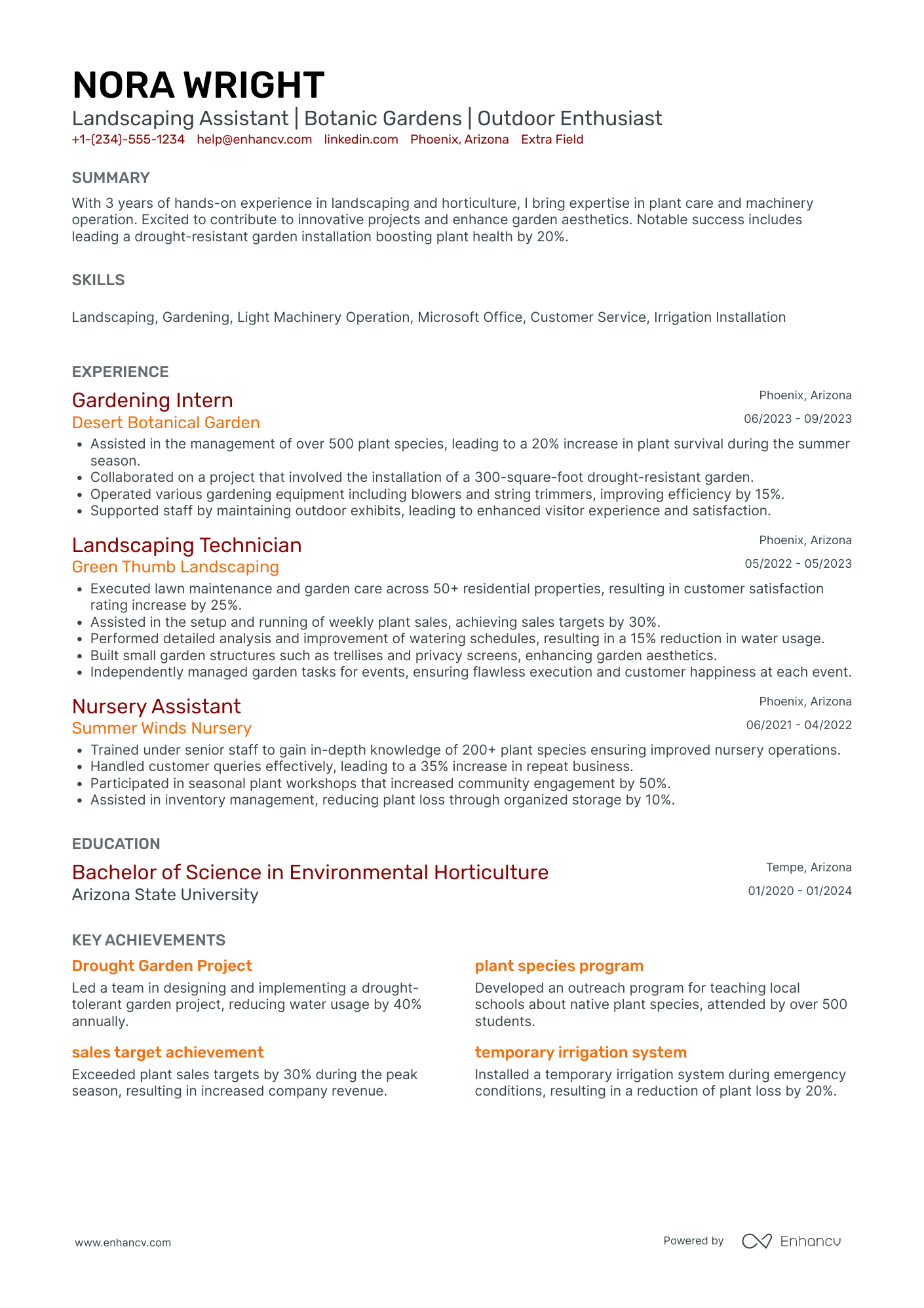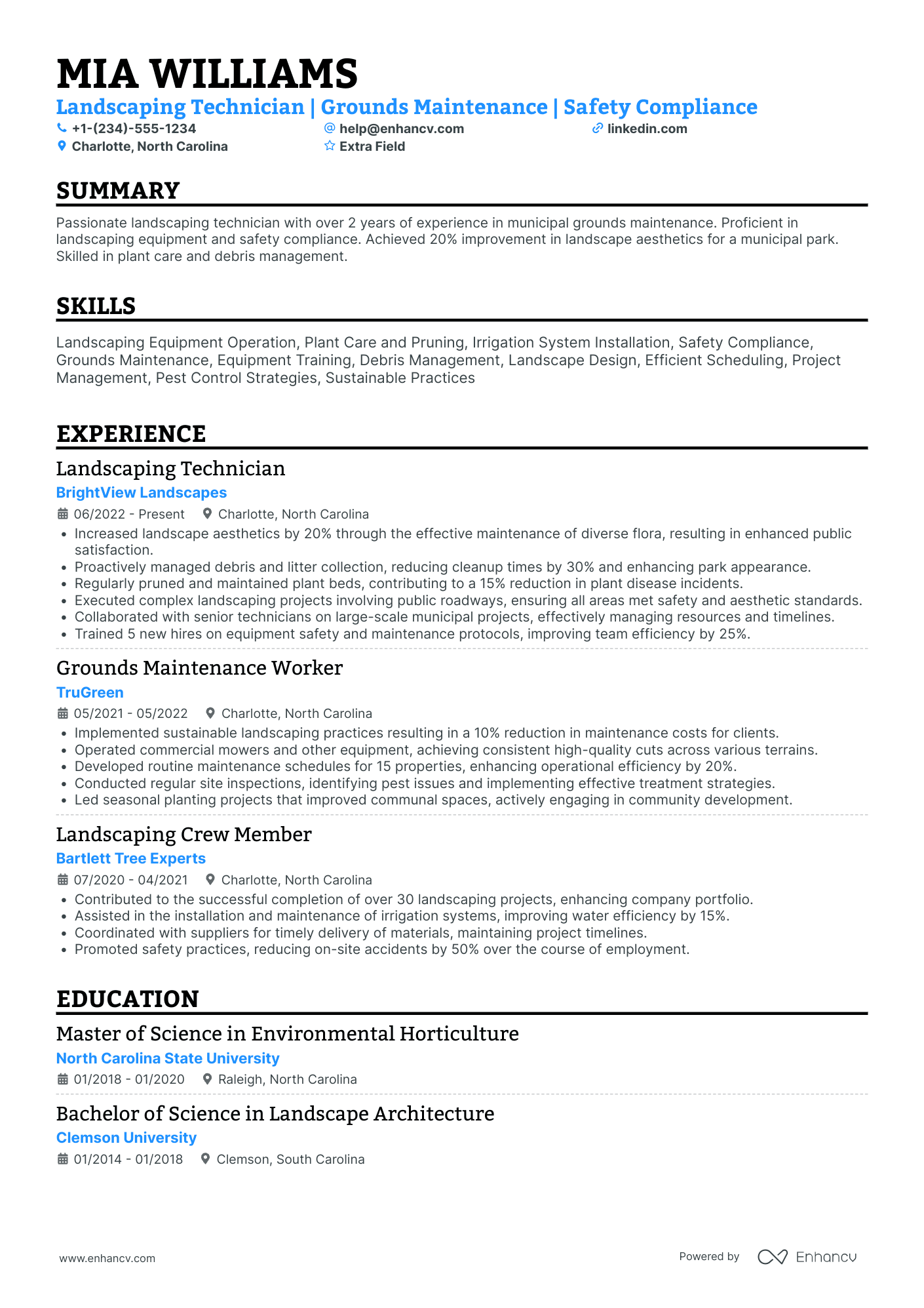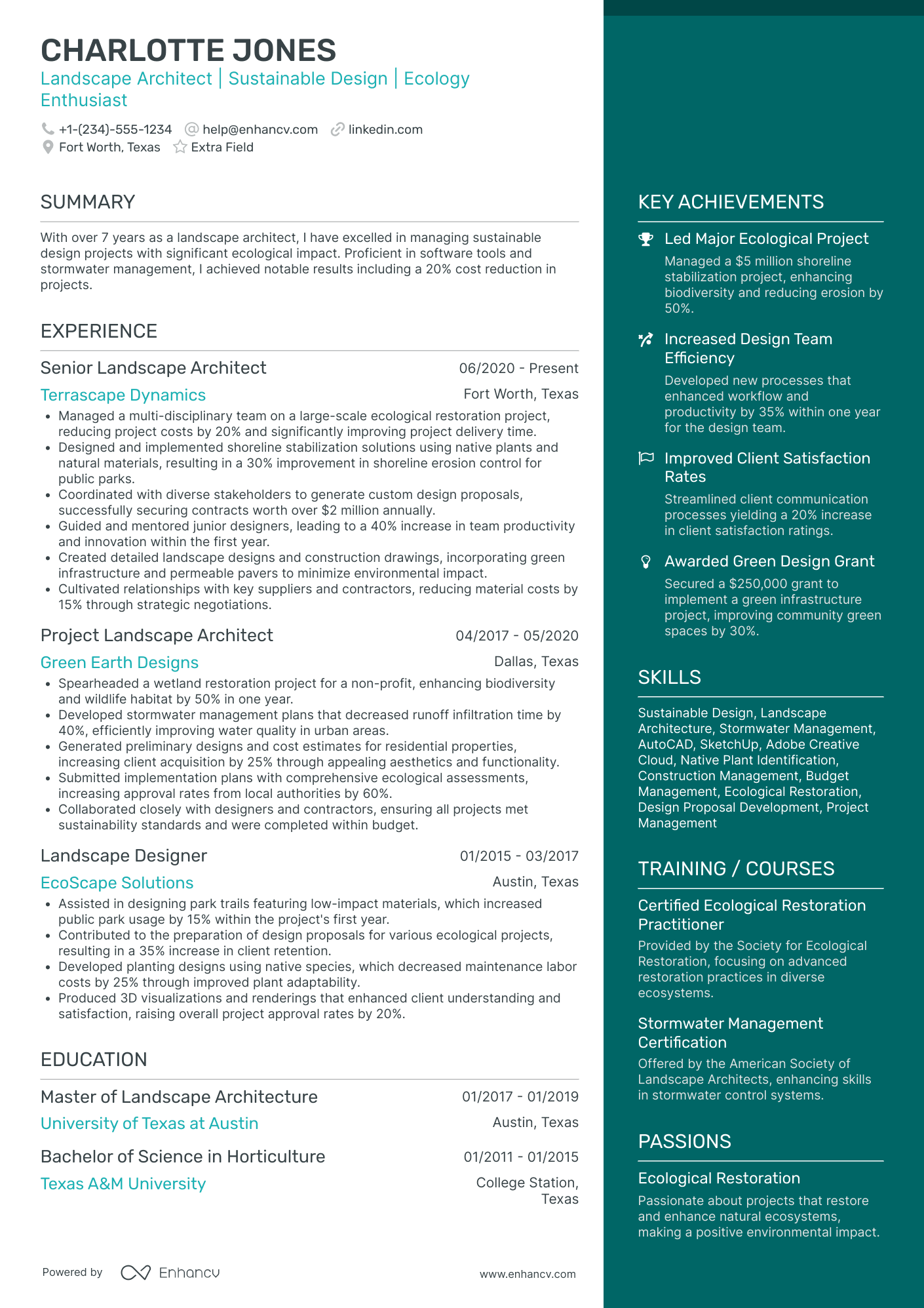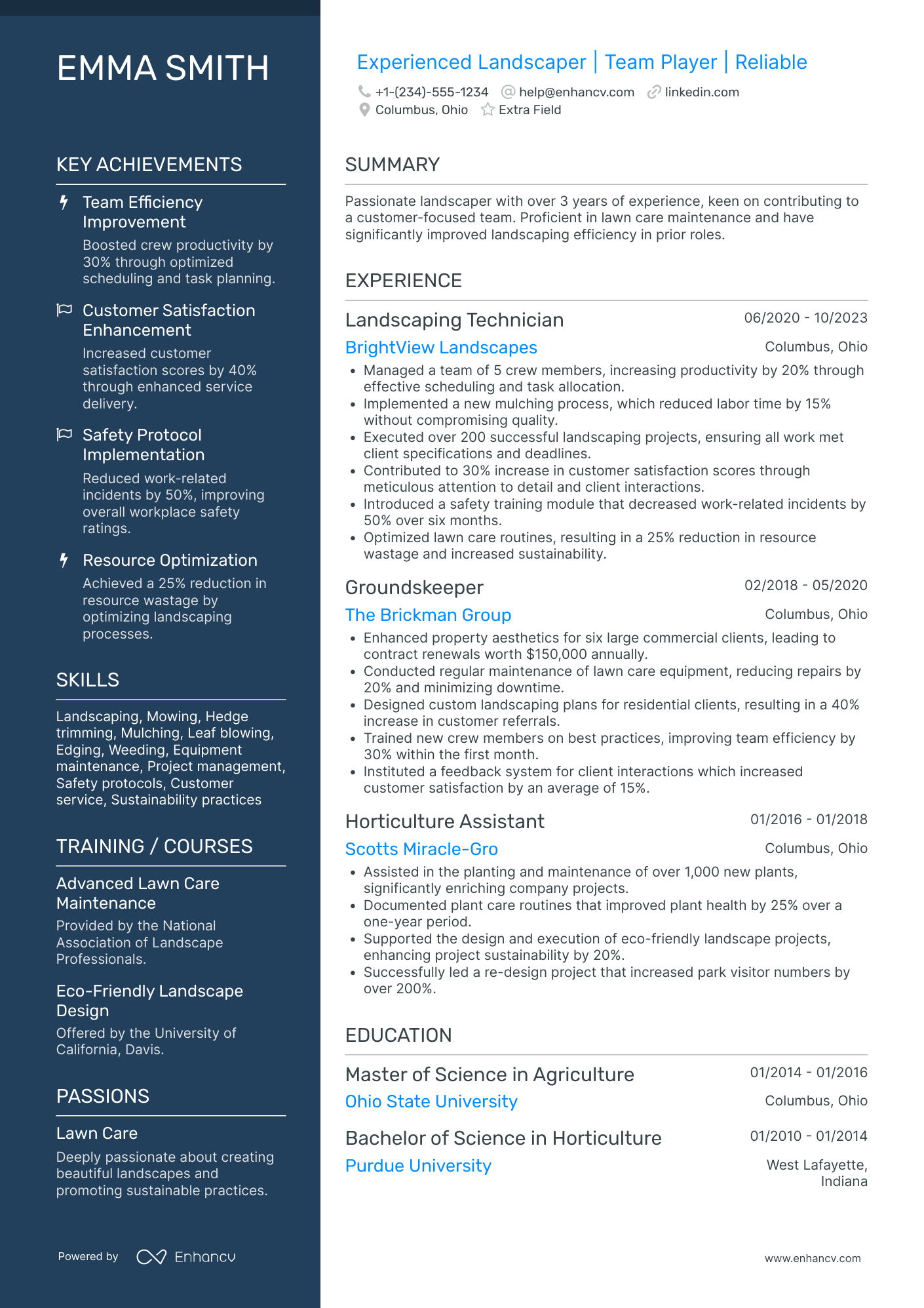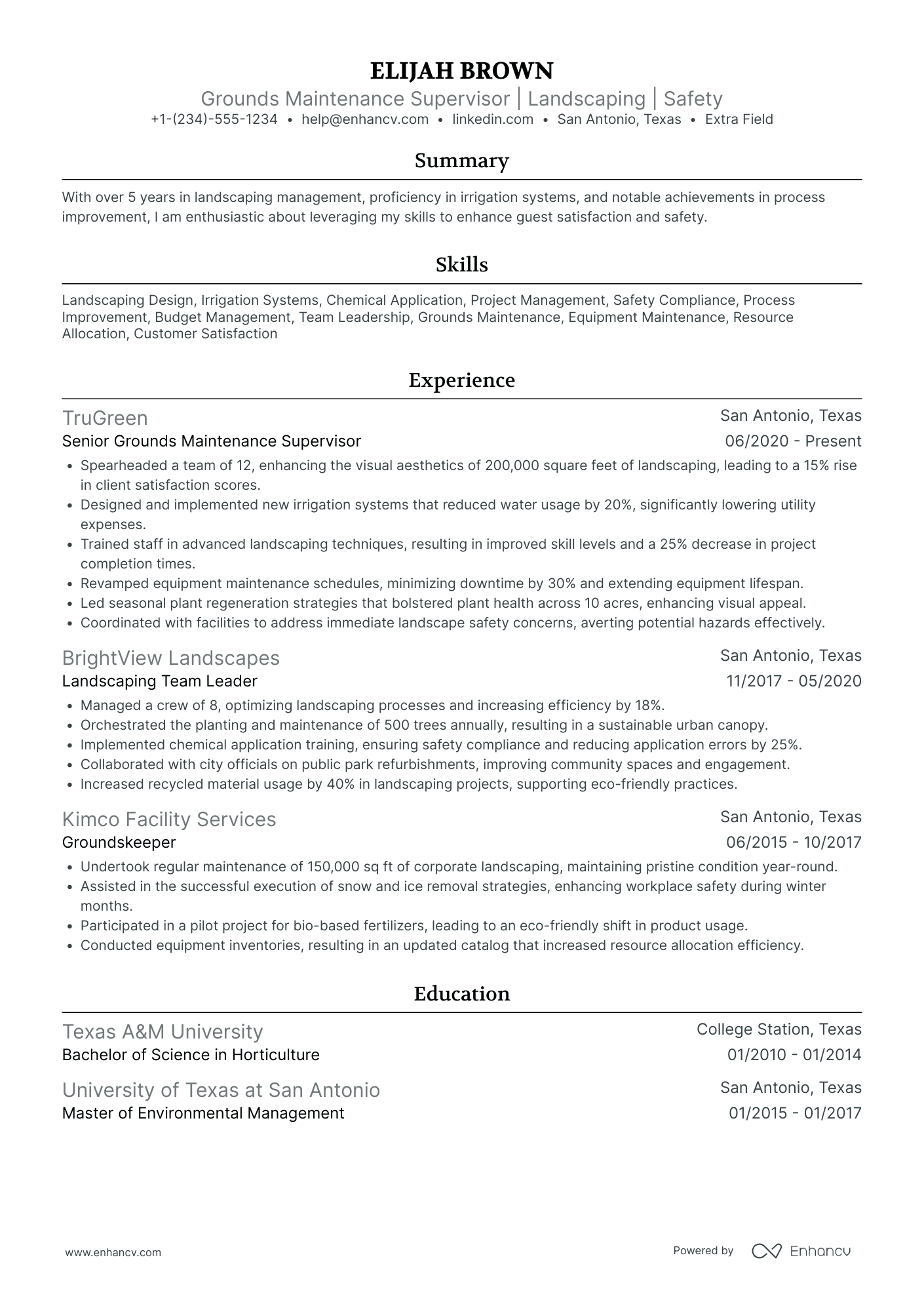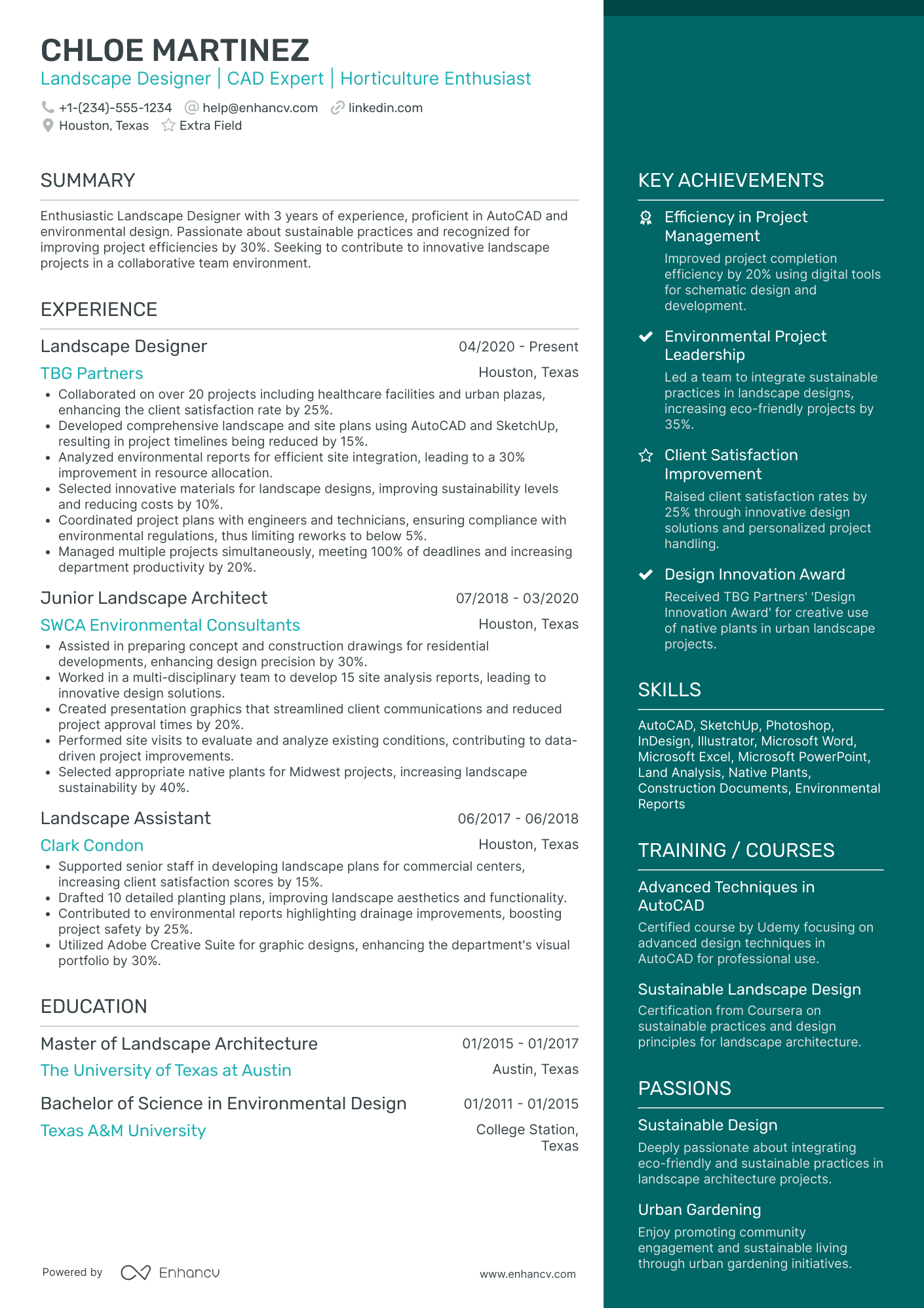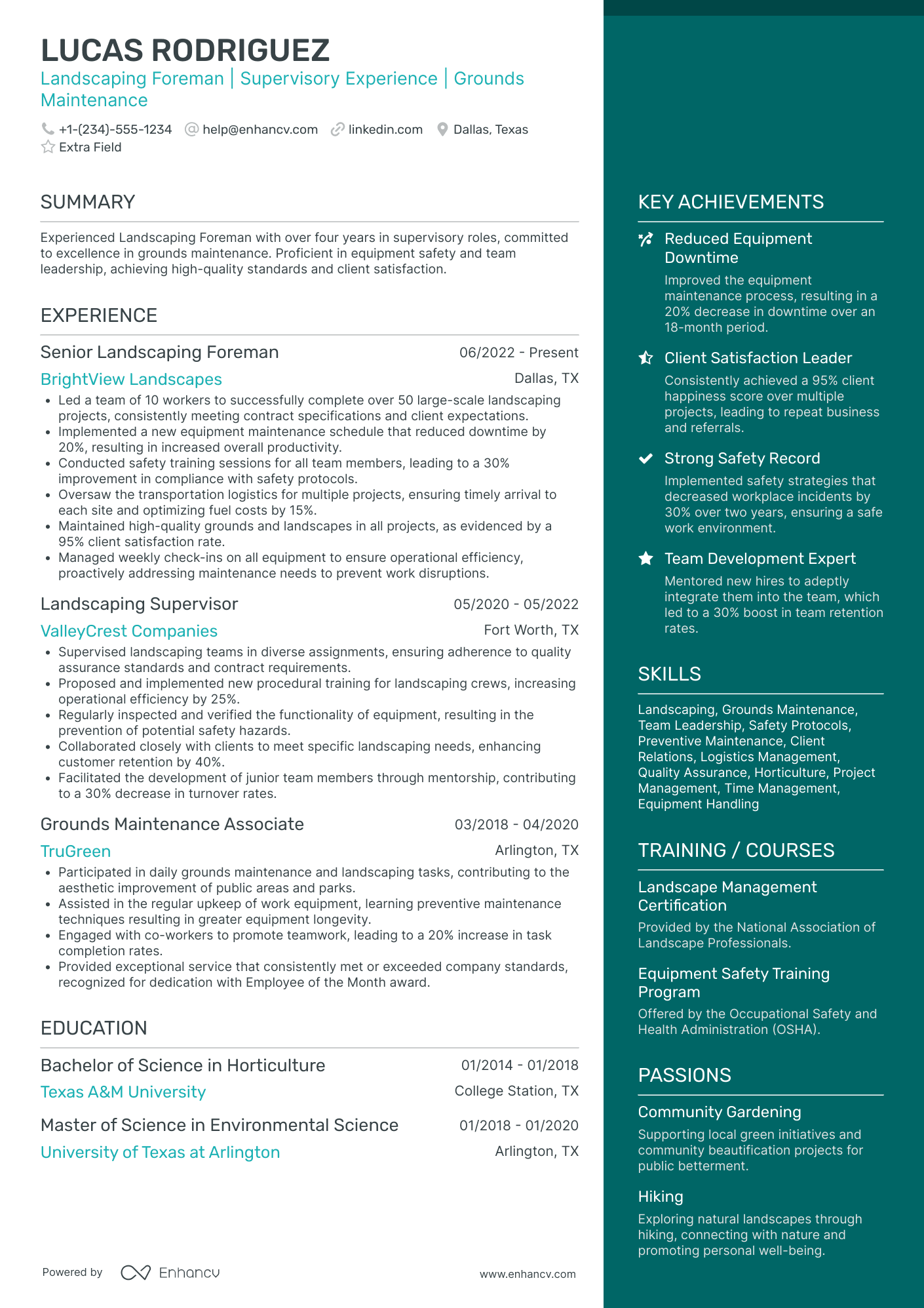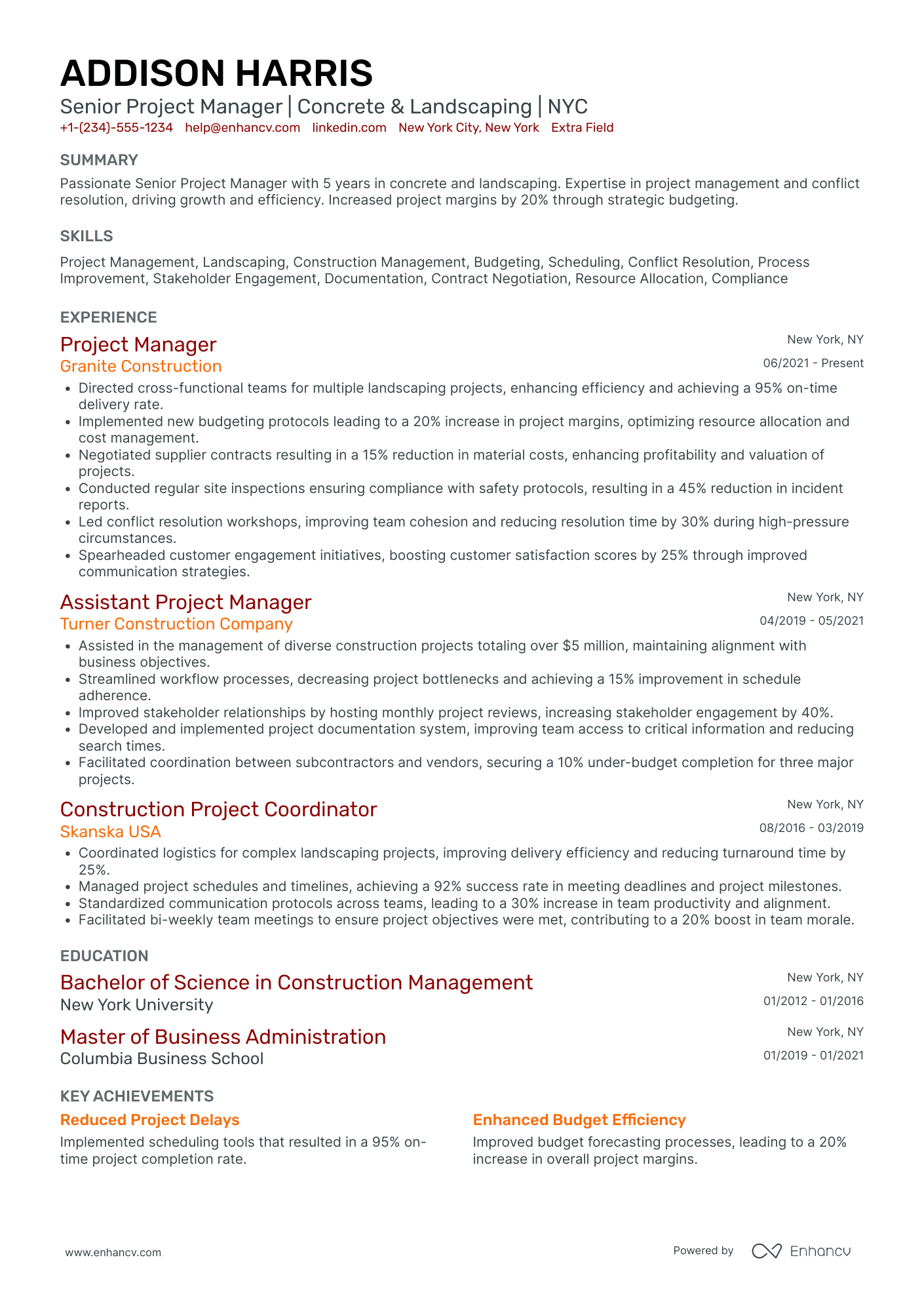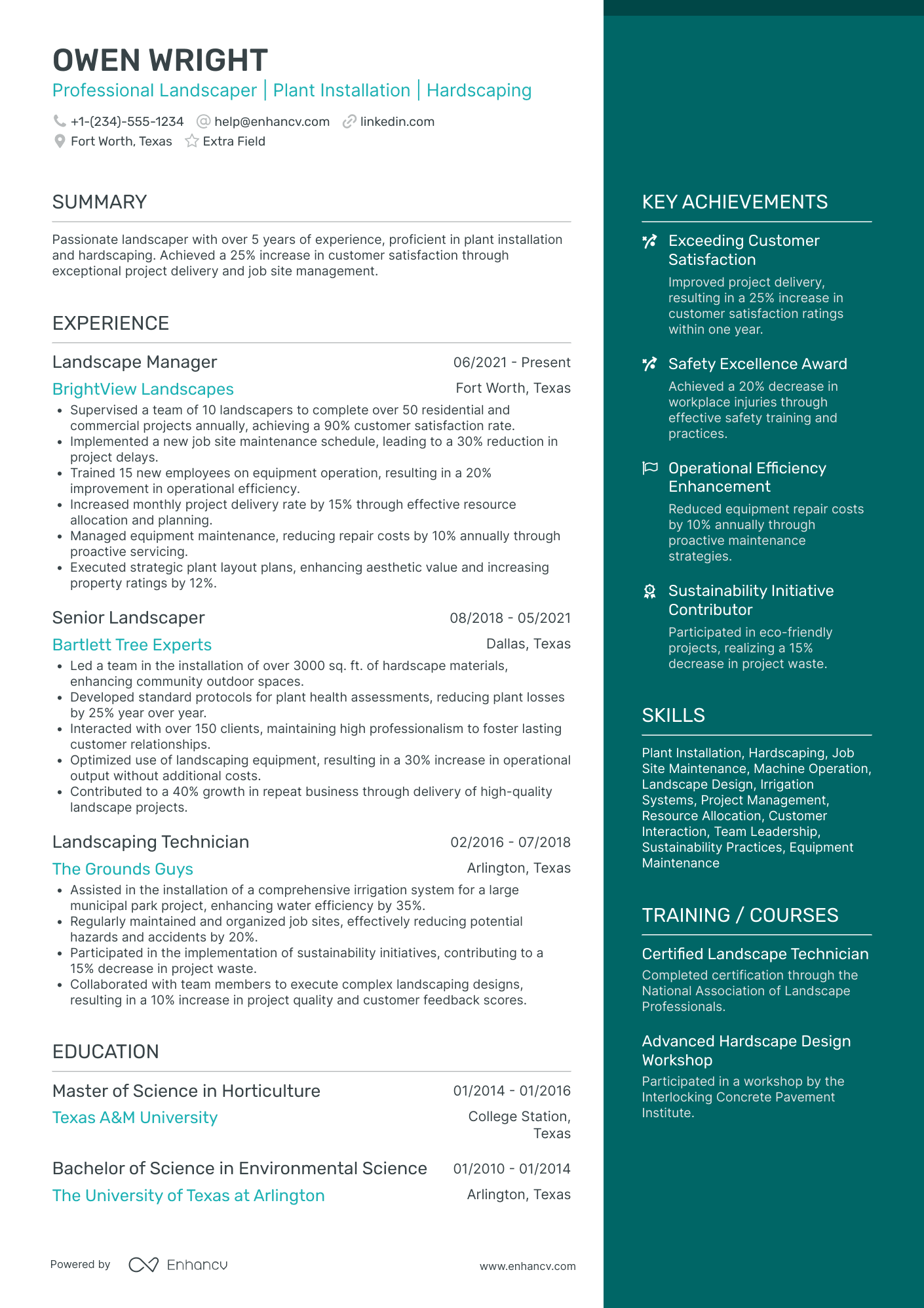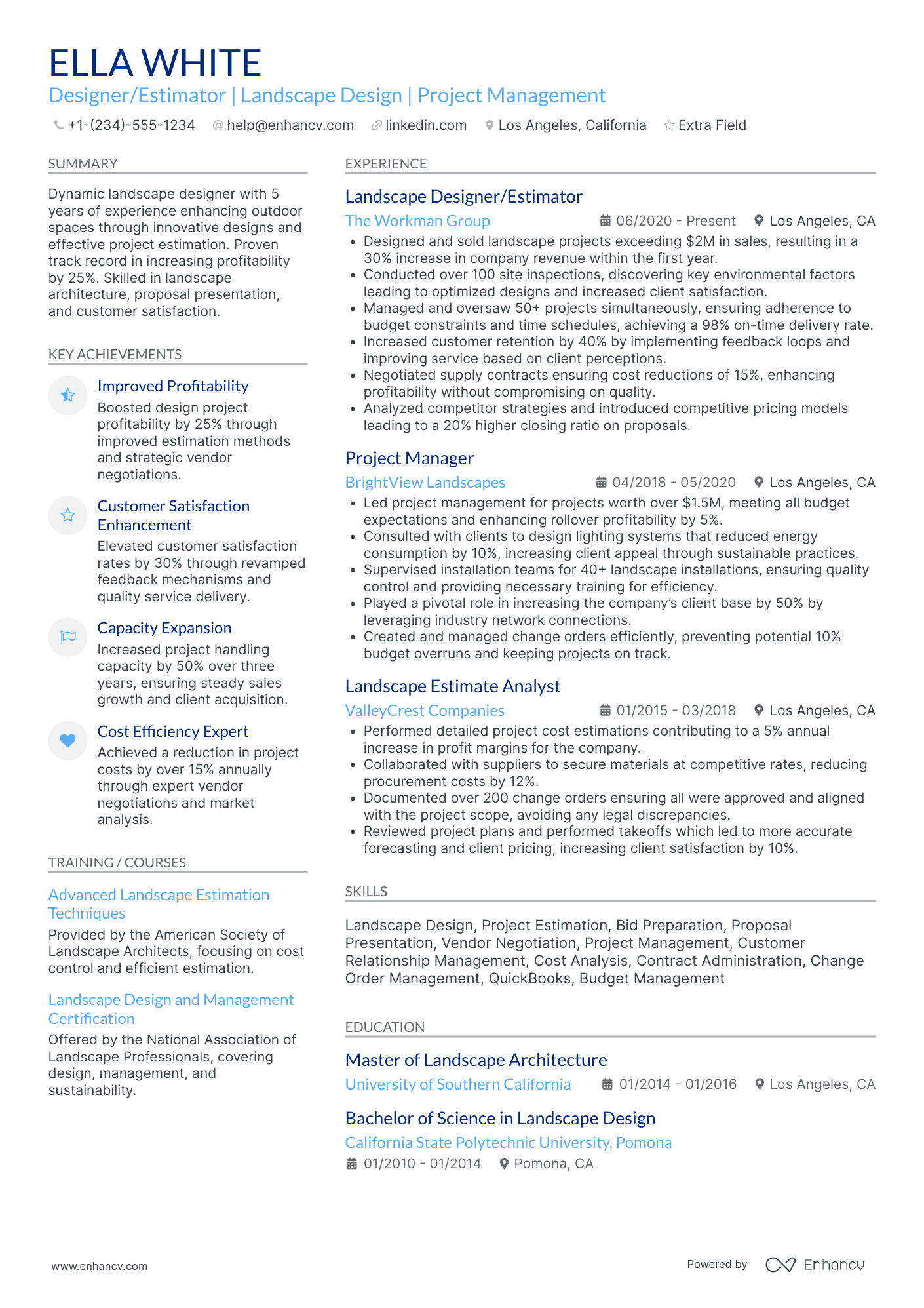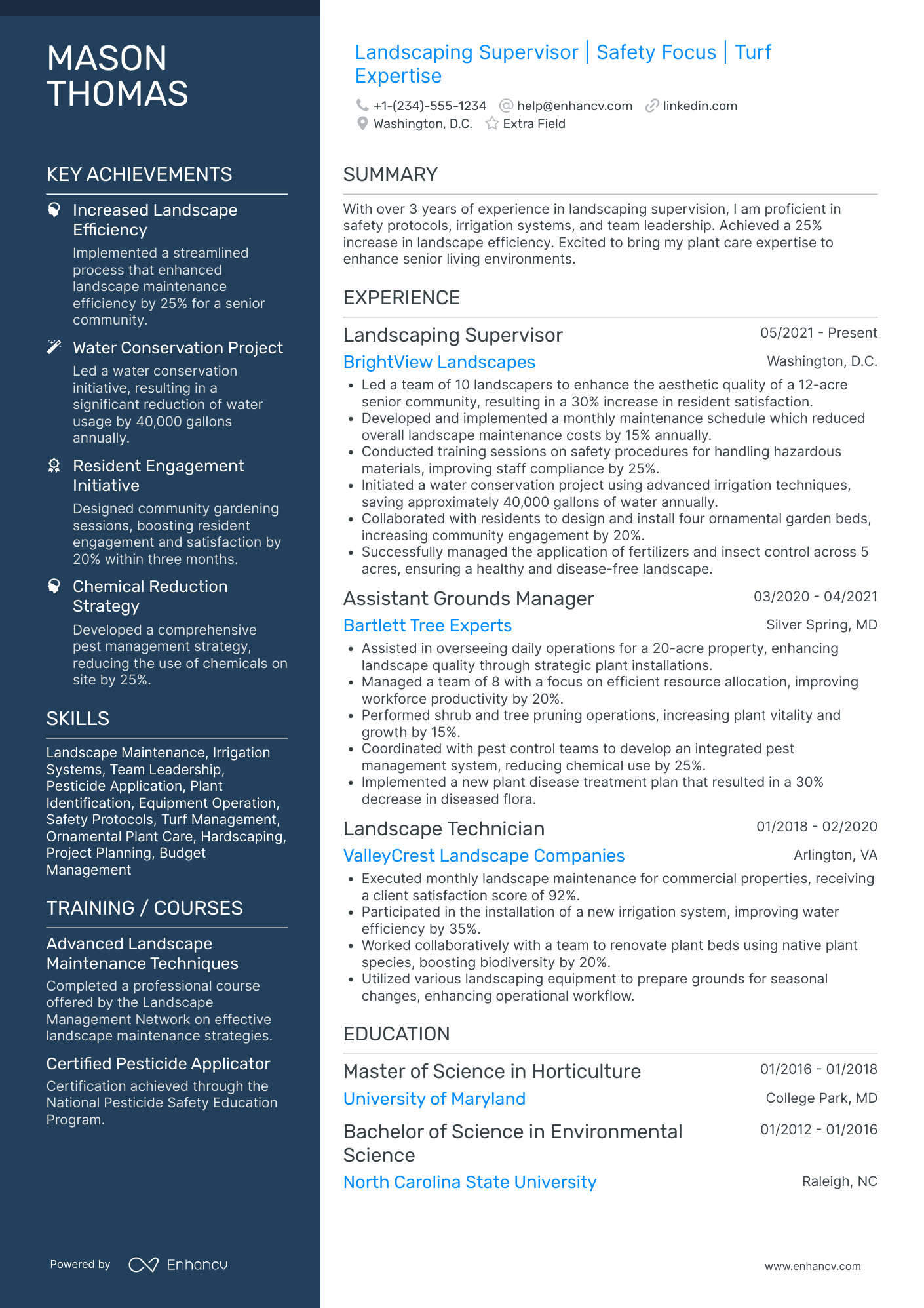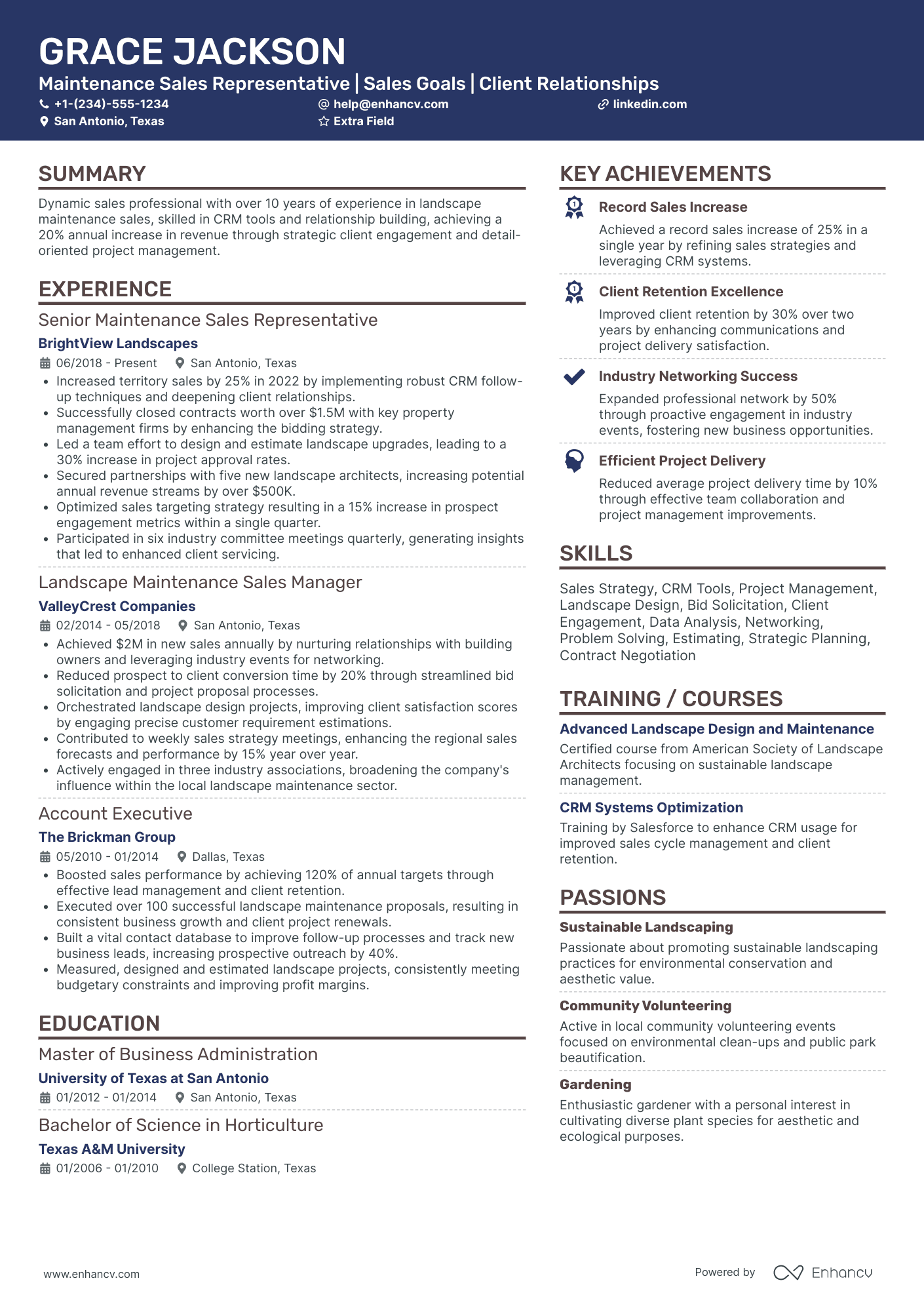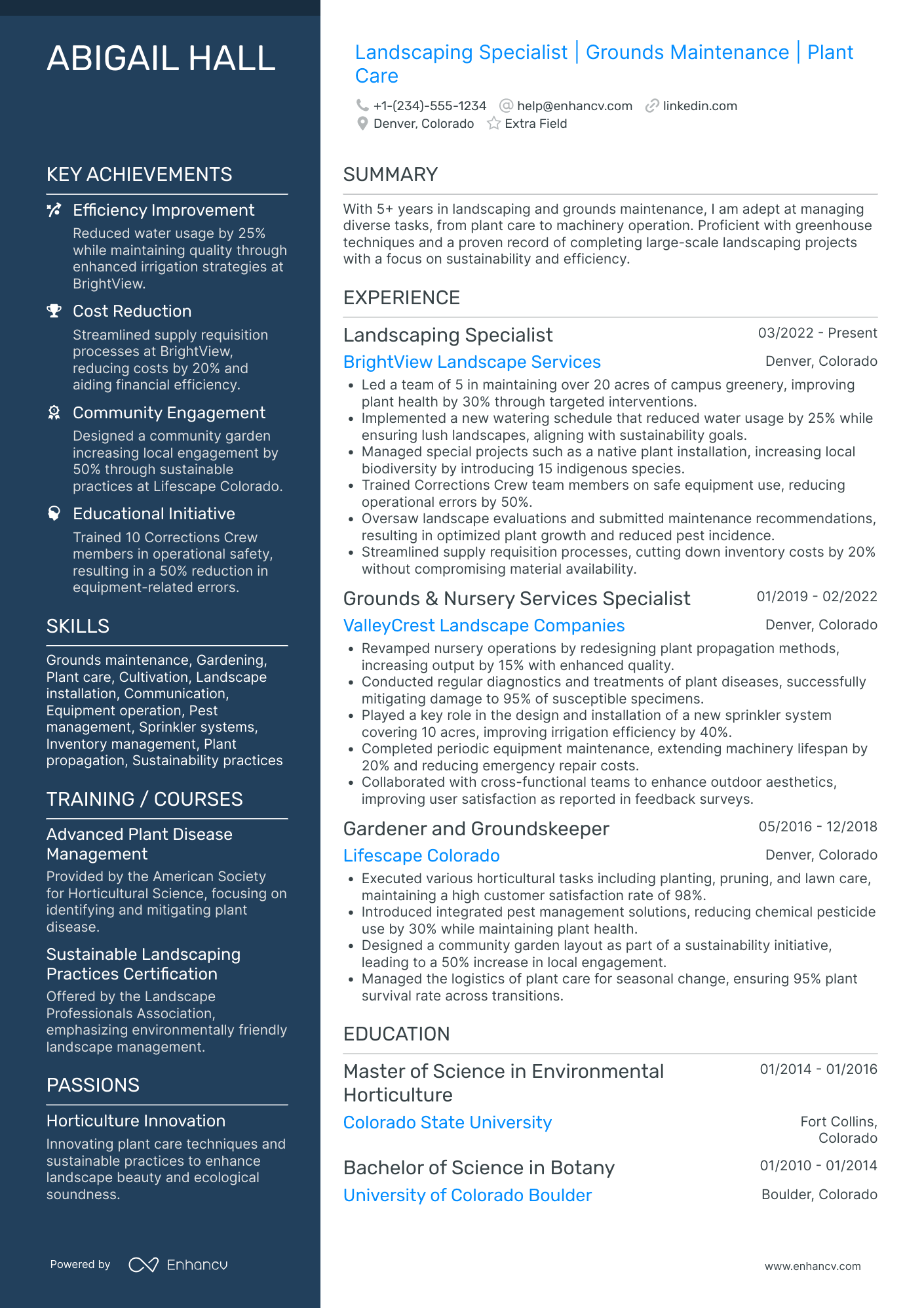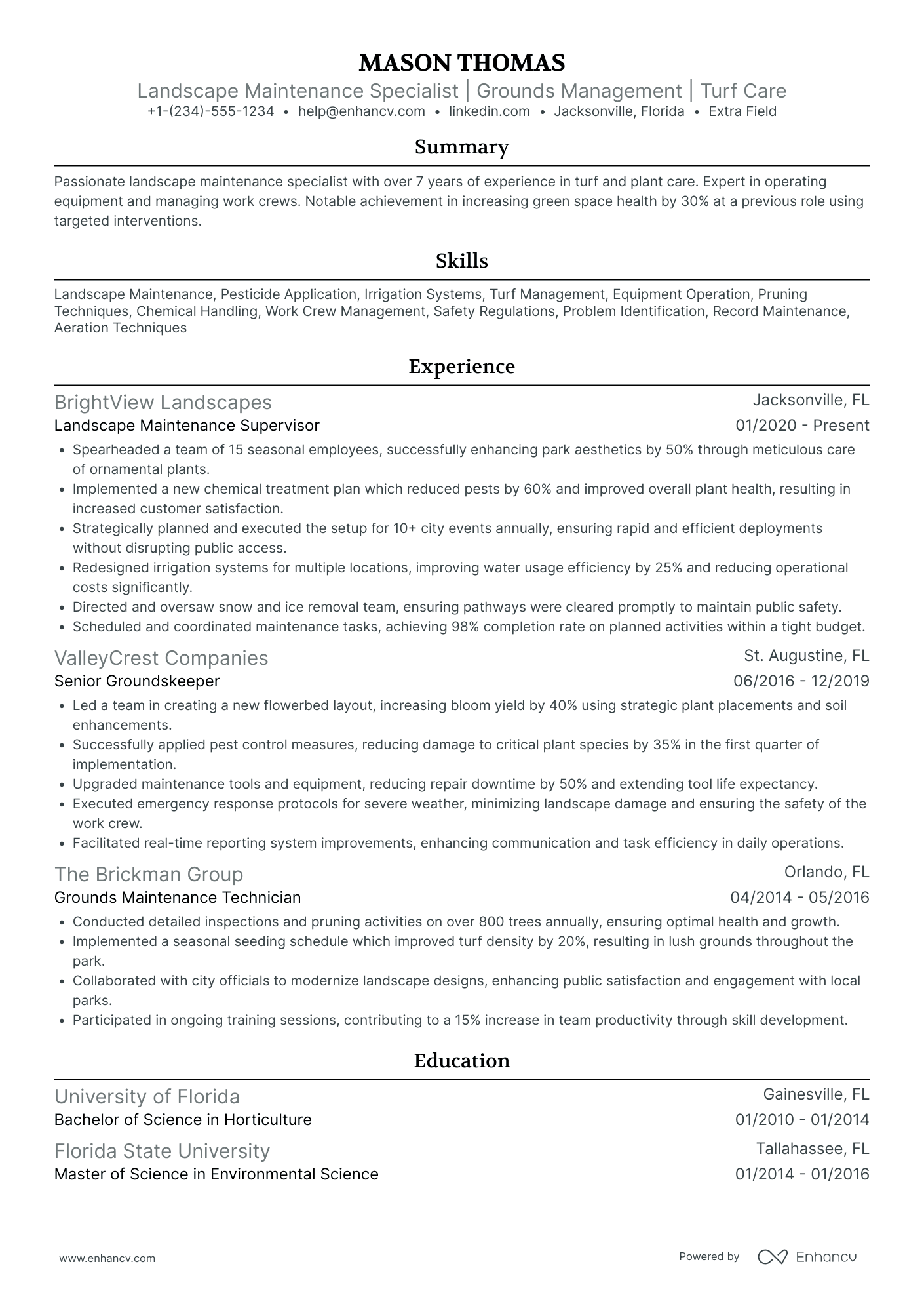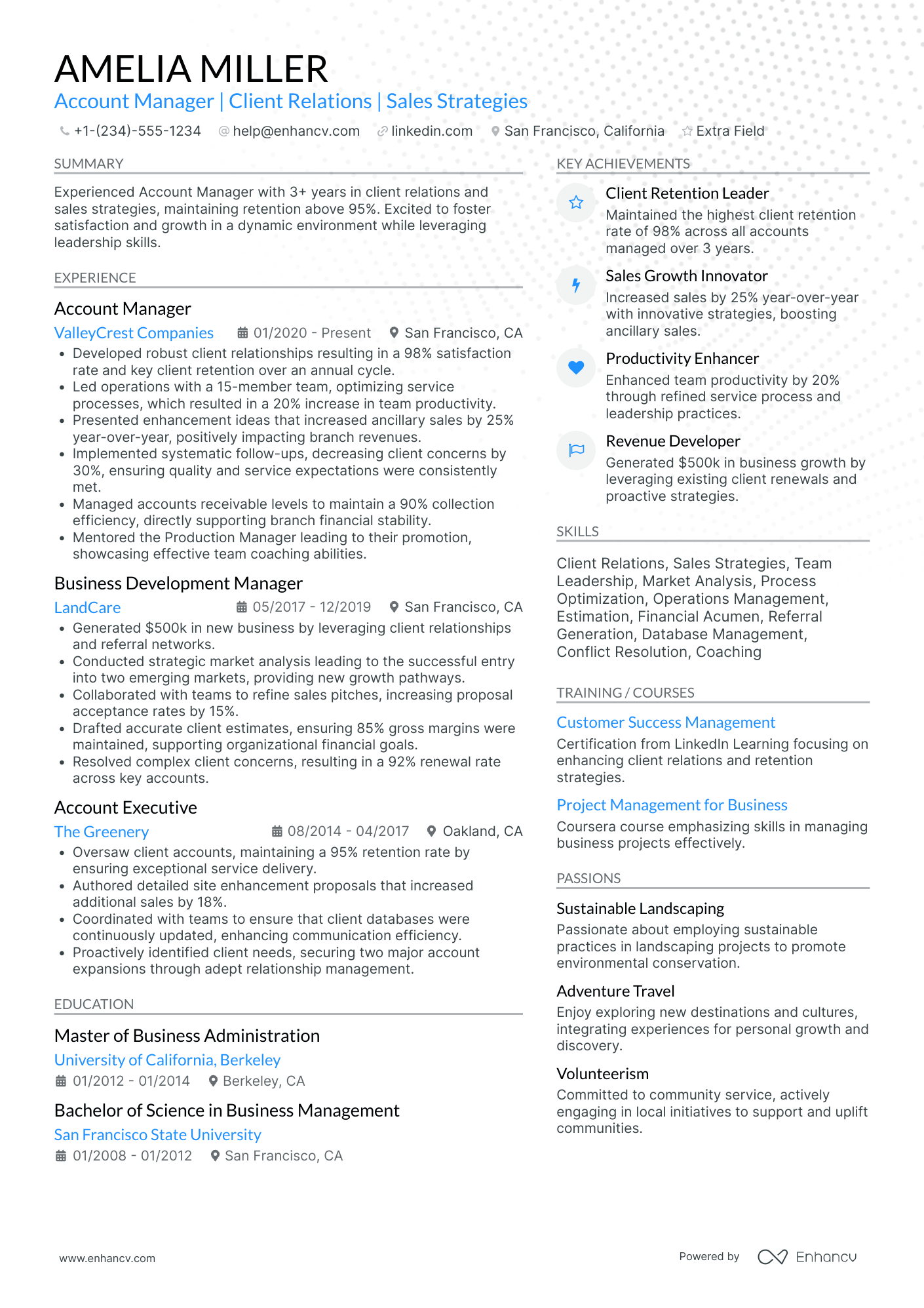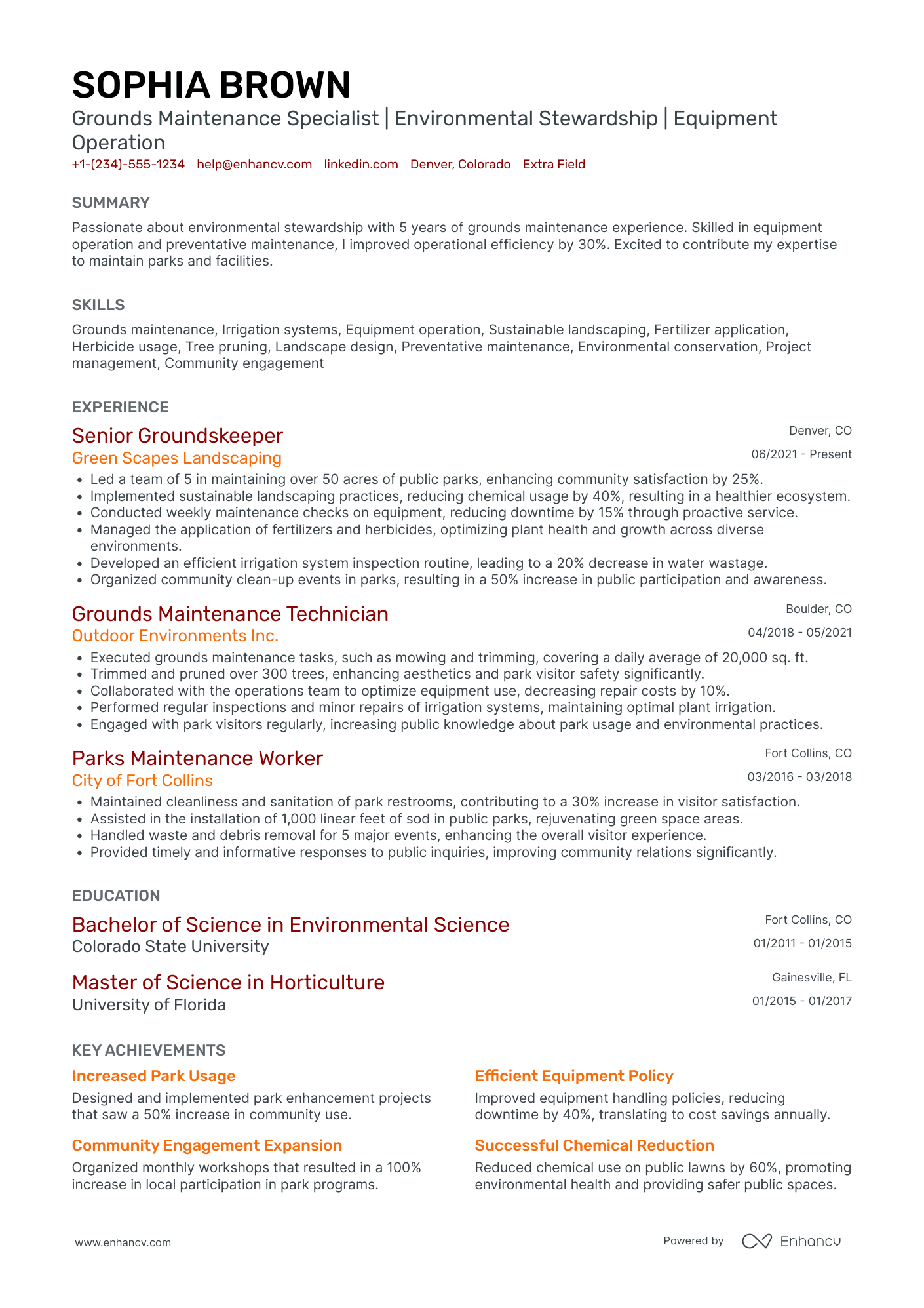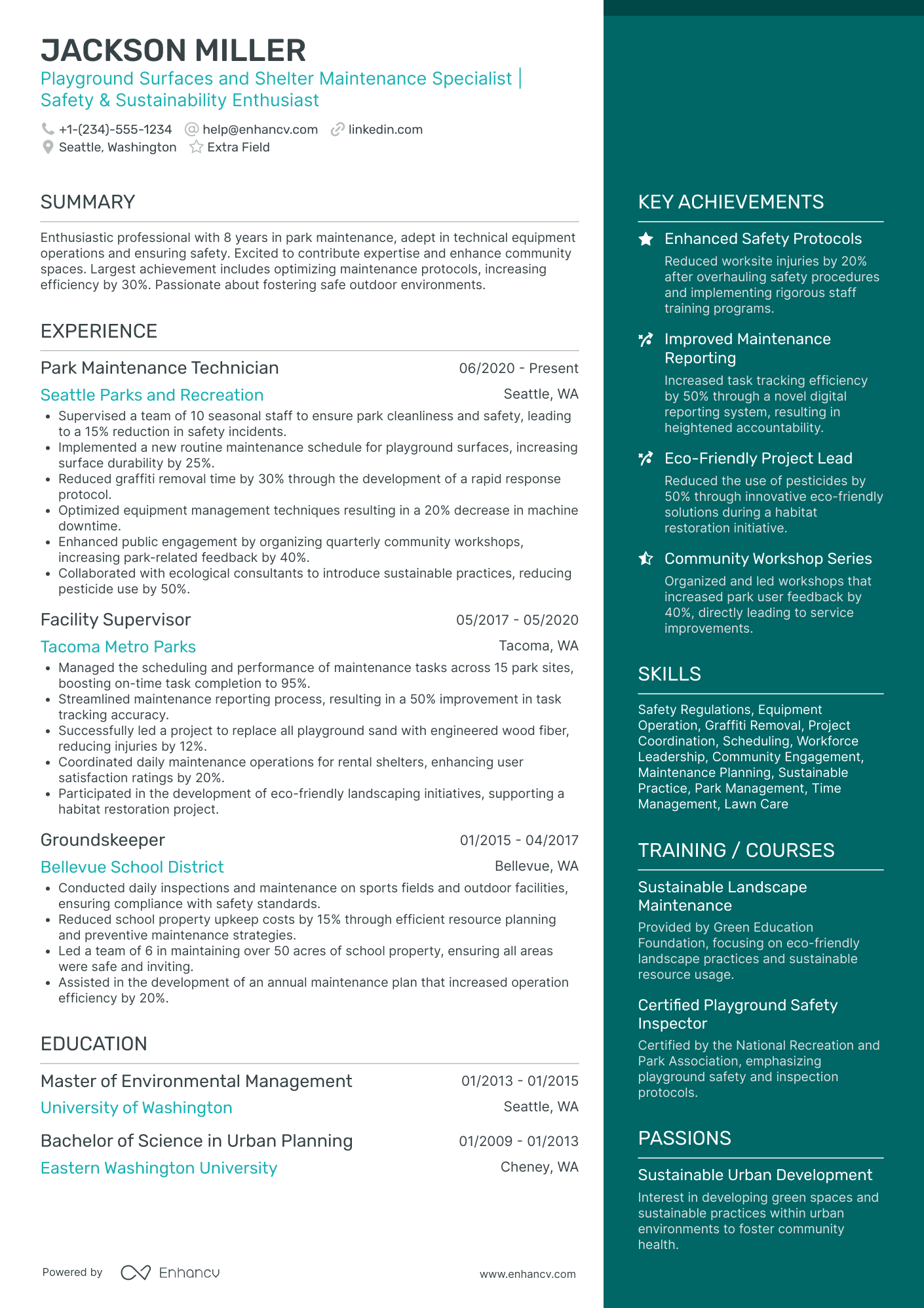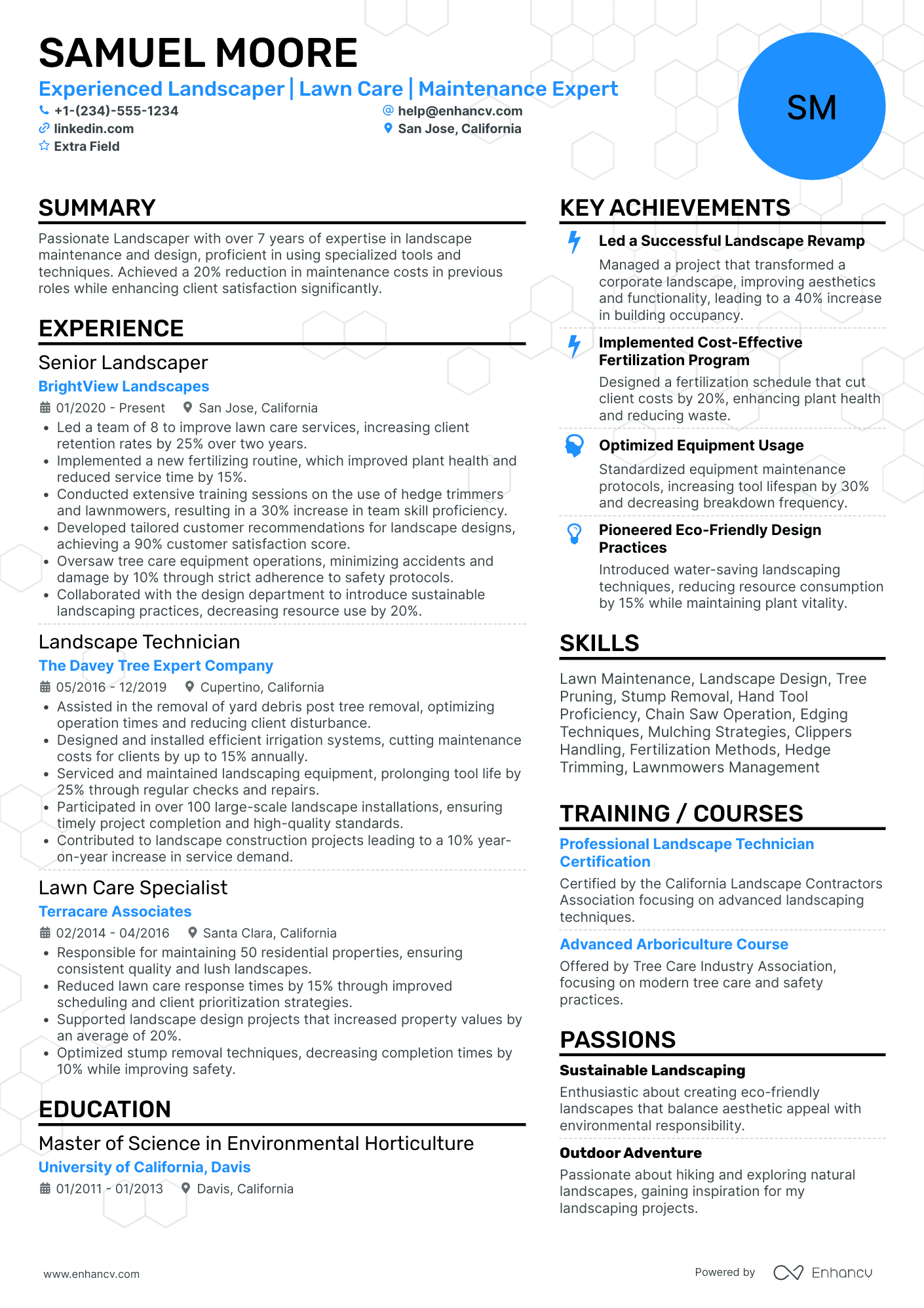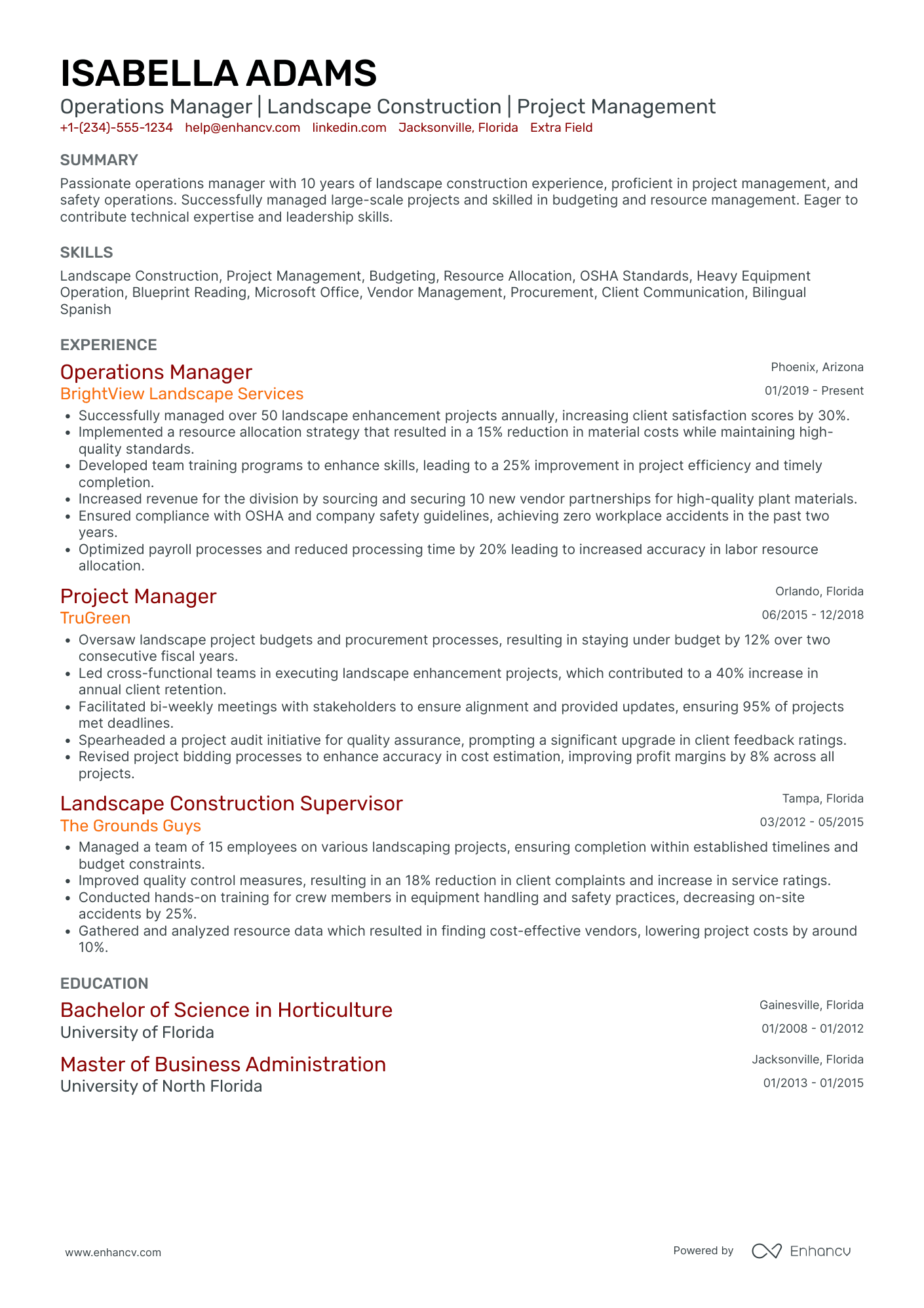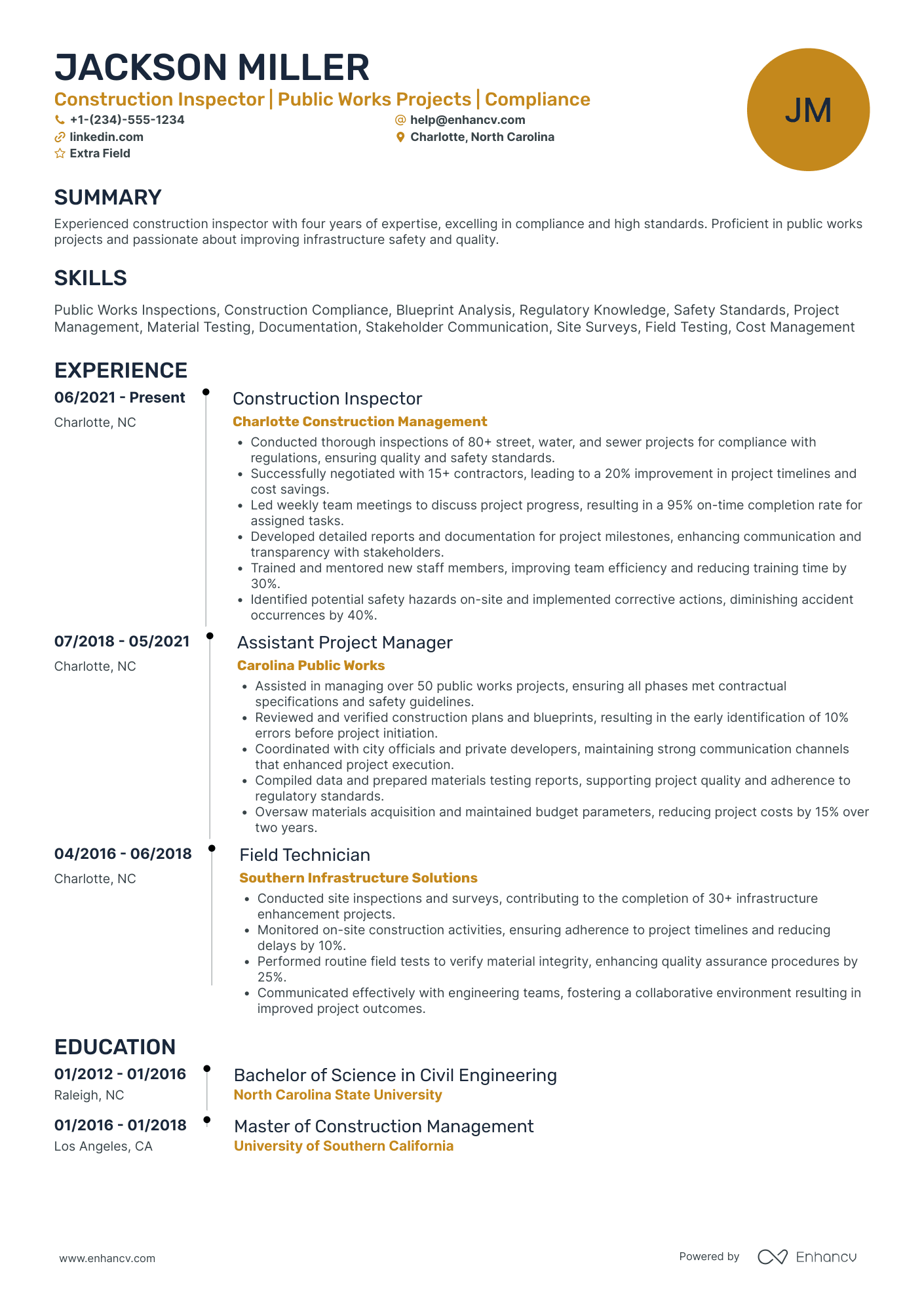Landscaping resumes often struggle to capture the physical nature and creative detail of your outdoor projects effectively. Our guide will show you how to weave your hands-on experience and design achievements into a compelling narrative that will catch an employer’s eye.
- Defining the highlights of your landscaping career through your resume summary, objective, and experience.
- Real-world landscaping resume samples with best practices on how to stand out amongst the endless pile of candidate resumes.
- Most in-demand landscaping resume skills and certifications across the industry.
- Standardizing your resume layout, while maintaining your creativity and individuality.
If the landscaping resume isn't the right one for you, take a look at other related guides we have:
- Maintenance Technician Resume Example
- Housekeeper Resume Example
- Electronic Technician Resume Example
- Maintenance Manager Resume Example
- Handyman Resume Example
- Electrician Resume Example
- Custodian Resume Example
- Cable Technician Resume Example
- Resident Assistant Resume Example
- Janitor Resume Example
Creating the best landscaping resume format: four simple steps
The most appropriate landscaping resume format is defined by precision and a systematic approach. What is more, it should reflect upon how your application will be assessed by recruiters. That is why we've gathered four of the most vital elements to keep in mind when designing your resume:
- It's all about presenting how your experience or skills align with the job. Use the reverse-chronological resume format , if your expertise is relevant to the landscaping role. Otherwise, select the functional skill-based resume format or the hybrid resume format to shift the focus to your skill set.
- Resume header - make sure you've filled out all relevant (and correct) information, like your contact details and link to your portfolio.
- Resume length - unless you've over a decade of applicable expertise in the field, stick with a one-page resume format. If you'd like to present more of your professional experience, go up to two pages.
- Resume file - submit your landscaping resume in a PDF format to ensure all information stays in the same place.
Think about the location of your application – Canadian resumes, for instance, might follow a different structure.
Upload & Check Your Resume
Drop your resume here or choose a file. PDF & DOCX only. Max 2MB file size.
PRO TIP
Highlight any significant extracurricular activities that demonstrate valuable skills or leadership.
Essential sections that should make up your landscaping resume include:
- The header - with your contact details (e.g. email and telephone number), link to your portfolio, and headline
- The summary (or objective) - to spotlight the peaks of your professional career, so far
- The experience section - with up to six bullets per role to detail specific outcomes
- The skills list - to provide a healthy mix between your personal and professional talents
- The education and certification - showing your most relevant degrees and certificates to the landscaping role
What recruiters want to see on your resume:
- Demonstrated knowledge of horticulture, including plant identification, pest management, and soil maintenance.
- Experience in operating landscaping equipment, such as lawn mowers, leaf blowers, and trimming tools.
- Examples of previous landscape design projects, showcasing creativity and the ability to follow design specifications.
- Physical fitness and the ability to perform labor-intensive tasks under various weather conditions.
- Proven track record in maintaining a safe work environment, including adhering to safety standards and proper handling of tools and machinery.
The experience section or the essence of your professional landscaping resume
Recruiters always have and always will appreciate well-written landscaping resume experience sections.
The experience section is perhaps the most crucial element of your professional presentation, as it needs to answer job requirements while showcasing your technical expertise and personality.
Create your best resume experience section yet by:
- Selecting only relevant experience items to the role you're applying for;
- Always ensure you've listed a metric to quantify your success alongside each experience item;
- Create a narrative that showcases your landscaping career succession: this goes to show the time and effort you've invested in the field to build your experience from the ground up;
- Within each experience bullet, consider a problem you've solved, the skills you've used, and the bigger impact this has made in the organization.
Take a look at how other real-life professionals have curated their experience with the landscaping samples below:
- Implemented eco-friendly landscaping techniques, reducing chemical usage by 40% while maintaining aesthetic appeal for high-end residential projects.
- Led a crew of 10 in the construction of a sustainable rain garden that mitigated stormwater runoff for a community park, which has flourished as a local ecosystem hub.
- Streamlined the company's landscape maintenance processes, utilizing advanced irrigation technology that saved clients an average of 25% on water bills.
- Designed and installed over 50 custom residential and commercial landscapes, prioritizing client needs and consistently receiving commendations for exceeding expectations.
- Managed the procurement of plants and materials, achieving a cost reduction of 15% through careful vendor selection and bulk purchasing agreements.
- Provided in-depth training for new hires on horticultural practices, boosting team productivity by 20% and enhancing plant survival rates.
- Coordinated with cross-functional teams to redevelop urban areas, incorporating green spaces into city planning which increased local biodiversity by 35%.
- Developed a client-tailored landscape maintenance program that led to a 95% customer retention rate over the fiscal year.
- Oversaw the successful installation of an automated irrigation system for a 200-acre golf course which improved turf health and yielded a 30% reduction in manual labor.
- Introduced native plant species into over 100 residential landscape designs, increasing local wildlife habitats and reducing maintenance costs for homeowners by up to 50%.
- Facilitated community workshops on sustainable gardening practices, engaging over 500 participants annually and fostering a more sustainable community mindset.
- Coordinated with suppliers to introduce a line of eco-conscious lawn care products, boosting sales and customer engagement by 20% each quarter.
- Directed the transformation of a derelict urban lot into a vibrant community garden, directly engaging over 200 community members in the project.
- Orchestrated the use of smart landscape technologies in over 30 residential projects, leading to a yearly average decrease of 10% in maintenance costs for clients.
- Negotiated with local nurseries to secure premium plant species for client projects, ensuring distinctive and robust landscape designs.
- Created and maintained annual planting schedules for over 500 acres of corporate campuses, which led to an improvement in seasonal color display and visitor satisfaction.
- Implemented a composting program for garden waste that recycled up to 60% of organic materials and supported soil health.
- Managed the landscape design for a multi-award-winning botanical garden that became a regional tourist attraction, increasing visitor numbers by 40%.
- Spearheaded a landscape renovation project for a historic city park, preserving its heritage while enhancing its functionality and visitor appeal.
- Optimized resource allocation for various landscaping projects, ensuring completion within budget and timeframe, which directly led to a 25% increase in profit margins.
- Developed a water conservation plan for regional park services, resulting in a 30% decrease in water usage and winning a state award for sustainability initiatives.
- Initiated a collaborative landscaping model involving local schools to enhance green spaces for educational programs, impacting over 2,000 students.
- Implemented innovative hardscape designs in high-traffic areas that improved public safety while maintaining aesthetic standards.
- Oversaw the seasonal decoration and landscaping for several municipal events, consistently delivered under budget and contributing to a 50% year-over-year growth in event attendance.
Quantifying impact on your resume
- List the total square footage of landscapes designed, installed, or maintained to demonstrate the extent of your hands-on experience.
- Include the number of projects completed within budget and on time, showing your financial management and efficiency.
- Mention the percentage of customer satisfaction based on feedback surveys to highlight customer service skills.
- Describe the number of different plant species you are knowledgeable about to establish your expertise in horticulture.
- Quantify the amount of money saved through cost-effective project management or sustainable practices to indicate your economic impact.
- Include the number of team members you've supervised or trained to show leadership and team development capabilities.
- Specify any awards or recognitions received in numbers to confirm your achievements and industry recognition.
- Identify the reduction in water usage or other resources due to your landscape designs to emphasize sustainability efforts.
Action verbs for your landscaping resume
Remember these four tips when writing your landscaping resume with no experience
You've done the work - auditing the job requirements for keywords and have a pretty good idea of the skill set the ideal candidate must possess.
Yet, your professional experience amounts to a summer internship .
Even if you have limited or no professional expertise that matches the role you're applying for, you can use the resume experience section to:
- List extracurricular activities that are relevant to the job requirements. Let's say you were editor-in-chief of your college newspaper or part of the engineering society. Both activities have taught you invaluable, transferrable skills (e.g. communication or leadership) that can be crucial for the job;
- Substitute jobs with volunteer experience. Participating in charity projects has probably helped you develop an array of soft skills (e.g. meeting deadlines and interpersonal communications). On the other hand, volunteering shows potential employers more about you: who you are and what are the causes you care about;
- Align job applications with your projects. Even your final-year thesis work could be seen as relevant experience, if it's in the same industry as the job you're applying for. Ensure you've listed the key skills your project has taught you, alongside tangible outcomes or your project success;
- Shift the focus to your transferrable skills. We've said it before, but recruiters will assess your profile upon both job requirements and the skills you possess. Consider what your current experience - both academic and life - has taught you and how you've been able to develop your talents.
Recommended reads:
PRO TIP
If you happen to have plenty of certificates, select the ones that are most applicable and sought-after across the industry. Organize them by relevance to the role you're applying for.
Balancing hard and soft skills in your landscaping resume
Recruiters indeed pay close attention to the specific hard and soft skills candidates possess. Hard skills refer to technical abilities or your proficiency in technologies, while soft skills are the personal attributes and qualities developed over your lifetime.
If you're unsure about effectively quantifying these skills on your resume, follow our step-by-step guide. It's crucial to first understand the key job requirements for the role. Doing so enables you to accurately list your:
- Hard skills in sections like skills, education, and certifications. Your technical expertise is straightforward to quantify. Most organizations find it sufficient to mention the certificates you've earned, along with your proficiency level.
- Soft skills within your experience, achievements, strengths, etc. Defining interpersonal communication traits in your resume can be challenging. Focus on showcasing the accomplishments you've achieved through these skills.
Remember, when tailoring your landscaping resume, ensure that the skills you list match exactly with those in the job requirements. For instance, if the job listing specifies "Microsoft Word," include this exact term rather than just "Word" or "MSO."
Top skills for your landscaping resume:
Horticulture knowledge
Plant identification
Soil management
Irrigation installation and repair
Landscape design
Garden maintenance
Pest and weed control
Equipment operation (mowers, trimmers, etc.)
Tree and shrub pruning
Landscape construction (patios, pathways, etc.)
Attention to detail
Creativity
Physical stamina
Time management
Communication skills
Problem-solving
Teamwork
Customer service orientation
Adaptability
Work ethic
PRO TIP
Bold the names of educational institutions and certifying bodies for emphasis.
Maximizing your landscaping resume: education and certification sections
To effectively showcase your industry knowledge in your landscaping resume, it's important to properly list your education and certifications.
For the education section, ensure you include:
- Higher education degrees pertinent to the industry or those at a postgraduate level;
- The start and end dates of your education, along with the name of the institution you graduated from;
- Your GPA and relevant coursework, but only if they are impressive and applicable to the role.
Additionally, create a separate certifications section to spotlight your most notable recognitions. Another excellent place to feature a leading industry certificate is in your resume header, right after your name.
Below is a list of key industry certifications that are often sought after by recruiters
The top 5 certifications for your landscaping resume:
- Certified Landscape Technician (CLT) - National Association of Landscape Professionals (NALP)
- Certified Professional Horticulturist (CPH) - American Society for Horticultural Science (ASHS)
- Landscape Industry Certified Manager (LICM) - National Association of Landscape Professionals (NALP)
- Certified Irrigation Technician (CIT) - Irrigation Association (IA)
- Certified Landscape Designer (CLD) - Association of Professional Landscape Designers (APLD)
PRO TIP
Showcase any ongoing or recent educational efforts to stay updated in your field.
Recommended reads:
Writing the landscaping resume summary or objective: achievements, keywords, dreams, and more
Deciding on whether to include a resume summary or resume objective should entirely depend on your career situation.
If you have:
- Plenty of relevant achievements you'd like to bring recruiters' focus to, make use of the resume summary. Ensure each of your achievements is quantified with concrete proof (e.g. % of cases solved).
- Less applicable experience, utilize the resume objective. Within the objective include a few noteworthy, past successes, followed up by your professional dreams.
As a bonus, you could define in either your landscaping resume summary or objective what makes you the perfect candidate for the role.
Think about your unique hard and soft skills that would make your expertise even more important to the job.
These landscaping professionals have completely covered the formula for the ideal resume introduction:
Resume summaries for a landscaping job
- With seven years of experience crafting serene and sustainable outdoor environments, I offer a deep knowledge of horticulture, landscape design, and project management. I've successfully renovated public parks, integrating native flora and modern aesthetics, reducing water usage by 30% without sacrificing beauty or functionality.
- Dynamic professional with a decade of experience in client relations and project oversight in technological sectors now seeking to bring proven leadership skills to a thriving landscape design firm. Keen to apply my expertise in negotiating, budget management, and team building to craft inspiring outdoor spaces.
- Experienced educator with a passion for environmental science and 5 years teaching botany and ecology. I aim to transition this expertise to landscape architecture, bringing innovative educational methods to design sustainable and engaging green spaces that foster community and environmental stewardship.
- A fervent advocate for green urban living with a background in community organization and a rich volunteer history supporting urban gardens. I am transitioning into professional landscaping with an aim to utilize my grassroots experience to create eco-friendly, social spaces that strengthen neighborhoods.
- Eager to embark on a professional journey in landscaping, with a robust enthusiasm for environmental preservation and aesthetic design. Committed to mastering technical skills such as soil management, plant selection, and CAD software to contribute actively to projects that enhance natural beauty and public engagement.
- Recent graduate with a degree in Environmental Science, bringing a fresh perspective and an eagerness to learn the intricacies of landscape design and management. Targeting to apply academic knowledge to real-world applications, aiming to create resilient and attractive landscapes that respect and enhance local ecosystems.
Other relevant sections for your landscaping resume
Apart from the standard landscaping resume sections listed in this guide, you have the opportunity to get creative with building your profile. Select additional resume sections that you deem align with the role, department, or company culture. Good choices for your landscaping resume include:
- Language skills - always ensure that you have qualified each language you speak according to relevant frameworks;
- Hobbies - you could share more about your favorite books, how you spend your time, etc. ;
- Volunteering - to highlight the causes you care about;
- Awards - for your most prominent landscaping professional accolades and achievements.
Make sure that these sections don't take too much away from your experience, but instead build up your landscaping professional profile.
Key takeaways
Writing your landscaping resume can be a structured and simple experience, once you better understand the organization's requirements for the role you're applying to. To sum up, we'd like to remind you to:
- Always select which experiences, skills, and achievements to feature on your resume based on relevancy to the role;
- In your resume summary, ensure you've cherry-picked your top achievements and matched them with the job ad's skills;
- Submit your landscaping resume as a one or two-page long document at the most, in a PDF format;
- Select industry leading certifications and list your higher education to highlight you have the basis for technical know-how;
- Quantify your people's skills through various resume sections (e.g. Strengths, Hobbies and interests, etc.) to show recruiters how your profile aligns with the organizational culture.
Landscaping resume examples
By Experience
Landscaping Assistant
By Role
